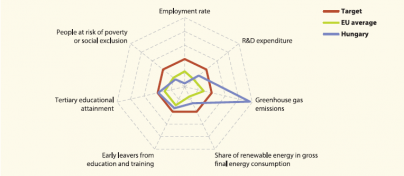Archive:Europe 2020 indicators - Hungary
- Data from July 2013. Most recent data: Further Eurostat information, Main tables.
This article is part of a set of statistical articles based on the Eurostat publication Smarter, greener, more inclusive - Indicators to support the Europe 2020 strategy. It provides recent statistics on the Europe 2020 strategy of the European Union (EU), focusing on the situation in Hungary.

Main statistical findings

By reducing its GHG emissions by 14 % since 2005, Hungary had already exceeded its emissions target in 2010, limiting the increase in emissions to 10 % by 2020. The country was closer to its Europe 2020 benchmarks than the EU average for tertiary education, R&D expenditure and early school leaving. Poverty levels started deteriorating during the economic crisis, thus opening a 30 % gap to the country’s social inclusion target. Despite the favourable increase in the employment rate from 2011 to 2012, a further increase in employment is needed for the 2020 target of 75 % to be reached. The use of renewable energy sources in the country has been increasing rapidly from 6.5 % of gross final energy consumption in 2008 to 9.1 % in 2011, but remained at some distance from the 13 % target.
Data sources and availability
More information about the origin of the data and the calculation of indicators can be obtained via the Europe 2020 indicators dedicated website.
Under 'Tables', click on the icons next to the indicators:
- 'Explanatory texts (metadata)' for a detailed overview of the collection and compilation methods;
- 'Information on the leaf' for data availability per country.
A more general overview of quality procedures can be found in Implementation of standard reference metadata for indicators - the ESMS Indicator Profile (ESMS-IP).
Context
Measures implemented to meet the national targets
- Employment: Implementation of the Employer Benefit System-Job Protection Act aimed at boosting employment by supporting the most disadvantaged employees to enter the labour market and keep their jobs; facilitate the integration of young unemployed in the labour market; promoting labour market participation of women and enhancing the reconciliation of work and family; strengthening active labour market policies.
- R&D expenditure: Developing a comprehensive RDI support scheme; drawing up a Science Policy Strategy aimed at providing basic infrastructure and financing to the academic sector; specific measures aimed at promoting R&D and innovation in agriculture, culture and healthcare.
- Climate and renewable energies: Setting up action plans for the implementation of the National Energy Strategy; measures aimed at promoting environmentally friendly modes of public transport such as the financing of gas-powered vehicles; drawing up regulatory, administrative and funding measures for boosting the share of renewable energy sources.
- Energy efficiency: Promoting energy efficiency and energy savings among the population and in the service and business sectors.
- Early school leaving: Expanding and promoting the quality of education in early childhood; improving the academic performance of children with special educational needs; continued implementation of the Public education Bridge programme, providing special training and support for poorly performing pupils.
- Tertiary education: Improving the efficiency and quality of tertiary education and promoting academic programmes more closely linked with the labour market needs; extensive state aid and funding system for increasing access to higher education; introduction of a vocational training system in higher education; support programmes for increasing the access of disadvantaged groups to higher education.
- Social inclusion: Launch of local programmes for equal opportunities, enhancing regional cooperation in the public services; development of a housing strategy targeting segregated settlements, promoting the success at school of disadvantaged children.
The European Commission's 2013 country-specific recommendations
- Employment: Strengthen the Public Employment Service, pursue active labour market policies and promote life-long learning.
- Social inclusion: Take swift and effective measures for addressing high poverty levels, in particular among the Roma community, by implementing the National Social Inclusion Strategy.
- Education: Further measures should be taken for preventing early-school leaving and enhancing the inclusiveness of the education system, in particular for children from Roma background; introduce higher education reforms for increasing tertiary attainment rates, especially for disadvantaged students.
- Others: Strengthen fiscal consolidation efforts; support the financial sector, strengthen financial regulation and supervision and help restore normal lending to the economy; introduce reforms in the taxation system including streamlining of corporate taxation, shifting away the tax burden on labour and improving tax compliance; reduce administrative burden for businesses; remove regulations in energy prices while supporting the most vulnerable and increase efficiency of the transport sector.
See also
Further Eurostat information
Publications
- Smarter, greener, more inclusive - indicators to support the Europe 2020 strategy (online publication, also downloadable as PDF file)
Main tables
Dedicated section
Methodology / Metadata
- Towards robust quality management for European Statistics - Communication from the Commission to the European Parliament and the Council COM(2011) 211 final.
Other information
- Regulation 223/2009 of 11 March 2009 on European statistics